Understanding and Leading Change
VerifiedAdded on 2023/01/13
|18
|4784
|36
AI Summary
This document provides insights into understanding and leading change in organizations. It covers the impact of change on leaders, teams, and individuals, as well as strategies to minimize negative impacts. The document also explores the drivers of change and different leadership styles. A case study on ASDA and Sainsbury is included to provide practical examples. Overall, this document offers valuable information and solutions for effectively managing change.
Contribute Materials
Your contribution can guide someone’s learning journey. Share your
documents today.
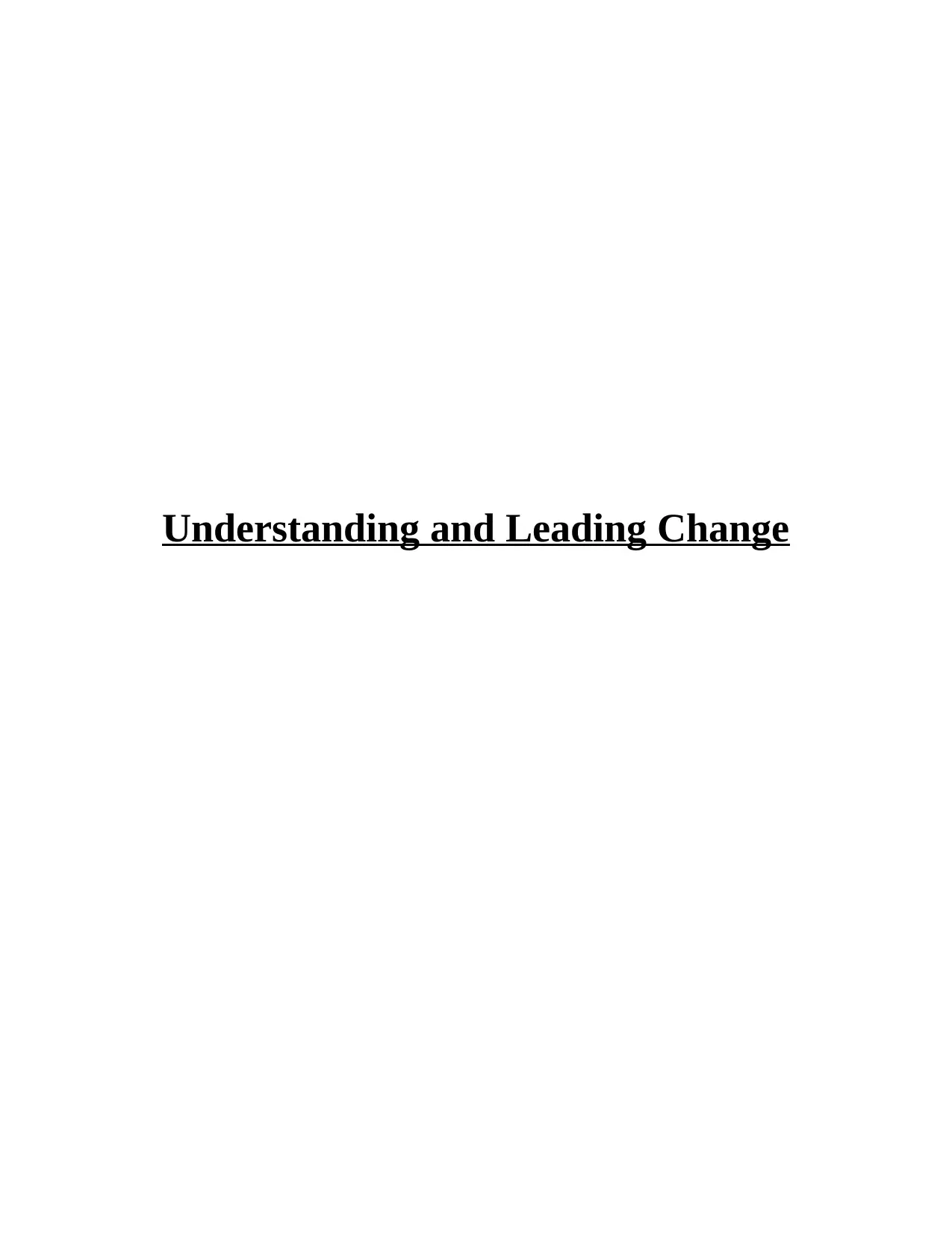
Understanding and Leading Change
Secure Best Marks with AI Grader
Need help grading? Try our AI Grader for instant feedback on your assignments.
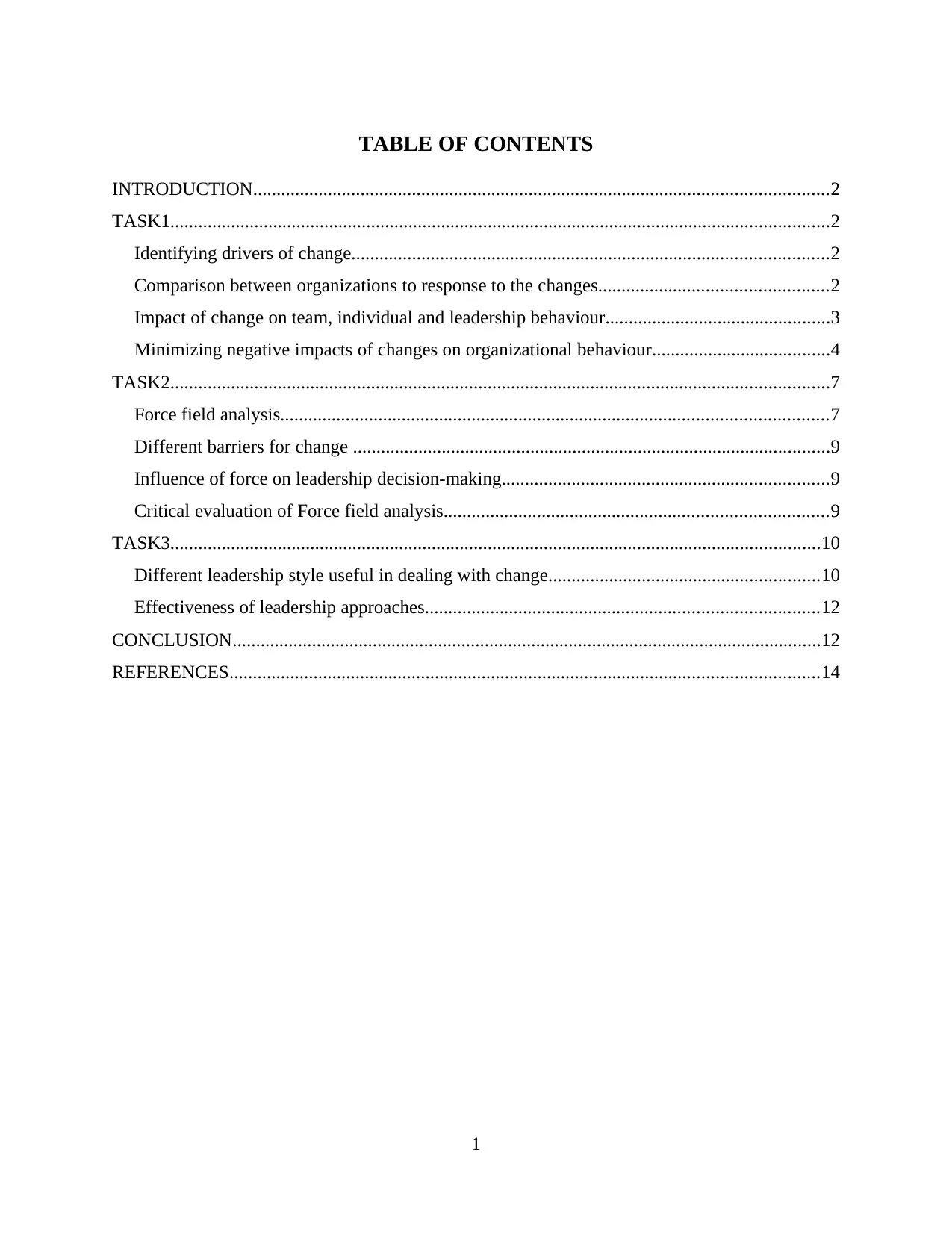
TABLE OF CONTENTS
INTRODUCTION...........................................................................................................................2
TASK1.............................................................................................................................................2
Identifying drivers of change......................................................................................................2
Comparison between organizations to response to the changes.................................................2
Impact of change on team, individual and leadership behaviour................................................3
Minimizing negative impacts of changes on organizational behaviour......................................4
TASK2.............................................................................................................................................7
Force field analysis.....................................................................................................................7
Different barriers for change ......................................................................................................9
Influence of force on leadership decision-making......................................................................9
Critical evaluation of Force field analysis..................................................................................9
TASK3...........................................................................................................................................10
Different leadership style useful in dealing with change..........................................................10
Effectiveness of leadership approaches....................................................................................12
CONCLUSION..............................................................................................................................12
REFERENCES..............................................................................................................................14
1
INTRODUCTION...........................................................................................................................2
TASK1.............................................................................................................................................2
Identifying drivers of change......................................................................................................2
Comparison between organizations to response to the changes.................................................2
Impact of change on team, individual and leadership behaviour................................................3
Minimizing negative impacts of changes on organizational behaviour......................................4
TASK2.............................................................................................................................................7
Force field analysis.....................................................................................................................7
Different barriers for change ......................................................................................................9
Influence of force on leadership decision-making......................................................................9
Critical evaluation of Force field analysis..................................................................................9
TASK3...........................................................................................................................................10
Different leadership style useful in dealing with change..........................................................10
Effectiveness of leadership approaches....................................................................................12
CONCLUSION..............................................................................................................................12
REFERENCES..............................................................................................................................14
1
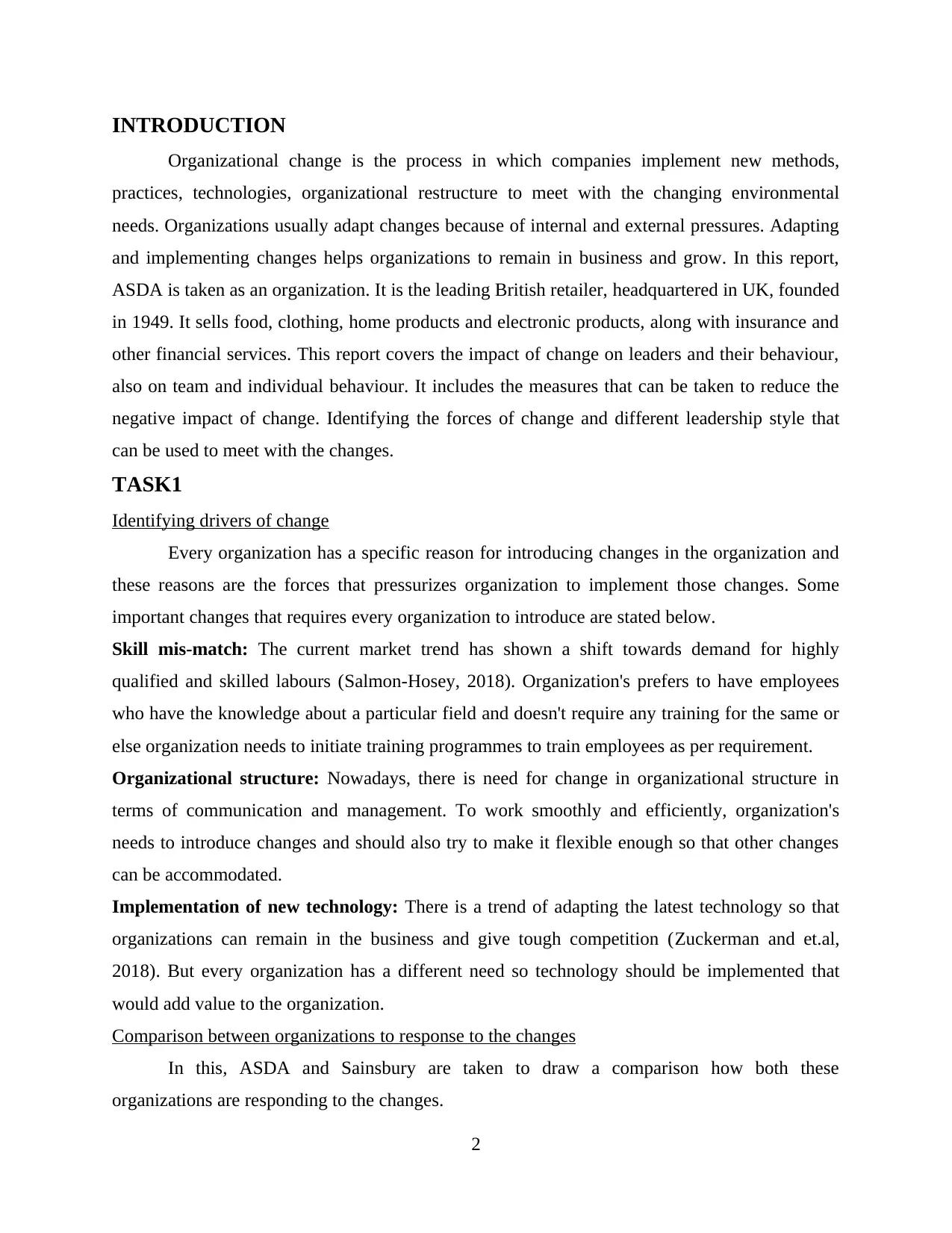
INTRODUCTION
Organizational change is the process in which companies implement new methods,
practices, technologies, organizational restructure to meet with the changing environmental
needs. Organizations usually adapt changes because of internal and external pressures. Adapting
and implementing changes helps organizations to remain in business and grow. In this report,
ASDA is taken as an organization. It is the leading British retailer, headquartered in UK, founded
in 1949. It sells food, clothing, home products and electronic products, along with insurance and
other financial services. This report covers the impact of change on leaders and their behaviour,
also on team and individual behaviour. It includes the measures that can be taken to reduce the
negative impact of change. Identifying the forces of change and different leadership style that
can be used to meet with the changes.
TASK1
Identifying drivers of change
Every organization has a specific reason for introducing changes in the organization and
these reasons are the forces that pressurizes organization to implement those changes. Some
important changes that requires every organization to introduce are stated below.
Skill mis-match: The current market trend has shown a shift towards demand for highly
qualified and skilled labours (Salmon-Hosey, 2018). Organization's prefers to have employees
who have the knowledge about a particular field and doesn't require any training for the same or
else organization needs to initiate training programmes to train employees as per requirement.
Organizational structure: Nowadays, there is need for change in organizational structure in
terms of communication and management. To work smoothly and efficiently, organization's
needs to introduce changes and should also try to make it flexible enough so that other changes
can be accommodated.
Implementation of new technology: There is a trend of adapting the latest technology so that
organizations can remain in the business and give tough competition (Zuckerman and et.al,
2018). But every organization has a different need so technology should be implemented that
would add value to the organization.
Comparison between organizations to response to the changes
In this, ASDA and Sainsbury are taken to draw a comparison how both these
organizations are responding to the changes.
2
Organizational change is the process in which companies implement new methods,
practices, technologies, organizational restructure to meet with the changing environmental
needs. Organizations usually adapt changes because of internal and external pressures. Adapting
and implementing changes helps organizations to remain in business and grow. In this report,
ASDA is taken as an organization. It is the leading British retailer, headquartered in UK, founded
in 1949. It sells food, clothing, home products and electronic products, along with insurance and
other financial services. This report covers the impact of change on leaders and their behaviour,
also on team and individual behaviour. It includes the measures that can be taken to reduce the
negative impact of change. Identifying the forces of change and different leadership style that
can be used to meet with the changes.
TASK1
Identifying drivers of change
Every organization has a specific reason for introducing changes in the organization and
these reasons are the forces that pressurizes organization to implement those changes. Some
important changes that requires every organization to introduce are stated below.
Skill mis-match: The current market trend has shown a shift towards demand for highly
qualified and skilled labours (Salmon-Hosey, 2018). Organization's prefers to have employees
who have the knowledge about a particular field and doesn't require any training for the same or
else organization needs to initiate training programmes to train employees as per requirement.
Organizational structure: Nowadays, there is need for change in organizational structure in
terms of communication and management. To work smoothly and efficiently, organization's
needs to introduce changes and should also try to make it flexible enough so that other changes
can be accommodated.
Implementation of new technology: There is a trend of adapting the latest technology so that
organizations can remain in the business and give tough competition (Zuckerman and et.al,
2018). But every organization has a different need so technology should be implemented that
would add value to the organization.
Comparison between organizations to response to the changes
In this, ASDA and Sainsbury are taken to draw a comparison how both these
organizations are responding to the changes.
2
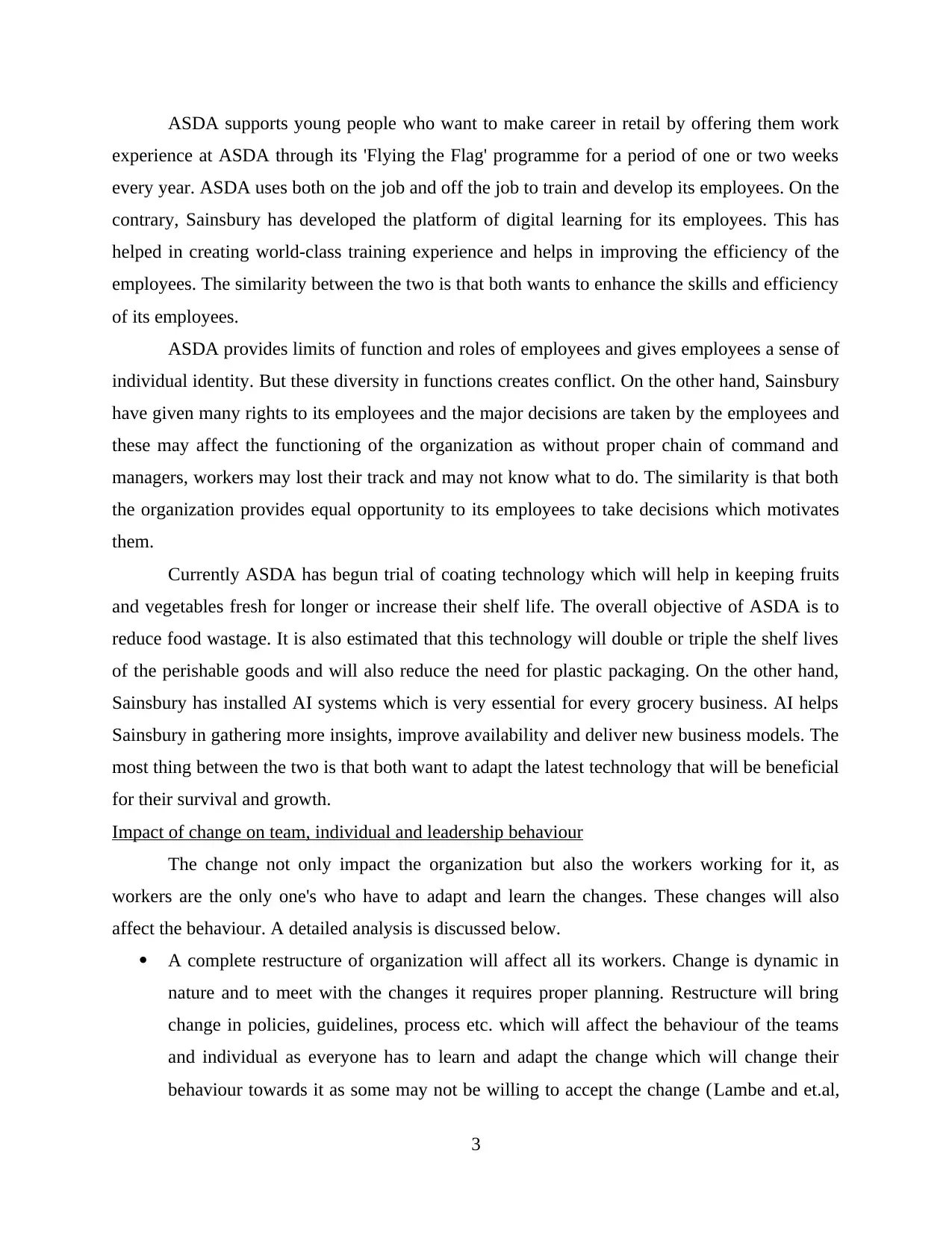
ASDA supports young people who want to make career in retail by offering them work
experience at ASDA through its 'Flying the Flag' programme for a period of one or two weeks
every year. ASDA uses both on the job and off the job to train and develop its employees. On the
contrary, Sainsbury has developed the platform of digital learning for its employees. This has
helped in creating world-class training experience and helps in improving the efficiency of the
employees. The similarity between the two is that both wants to enhance the skills and efficiency
of its employees.
ASDA provides limits of function and roles of employees and gives employees a sense of
individual identity. But these diversity in functions creates conflict. On the other hand, Sainsbury
have given many rights to its employees and the major decisions are taken by the employees and
these may affect the functioning of the organization as without proper chain of command and
managers, workers may lost their track and may not know what to do. The similarity is that both
the organization provides equal opportunity to its employees to take decisions which motivates
them.
Currently ASDA has begun trial of coating technology which will help in keeping fruits
and vegetables fresh for longer or increase their shelf life. The overall objective of ASDA is to
reduce food wastage. It is also estimated that this technology will double or triple the shelf lives
of the perishable goods and will also reduce the need for plastic packaging. On the other hand,
Sainsbury has installed AI systems which is very essential for every grocery business. AI helps
Sainsbury in gathering more insights, improve availability and deliver new business models. The
most thing between the two is that both want to adapt the latest technology that will be beneficial
for their survival and growth.
Impact of change on team, individual and leadership behaviour
The change not only impact the organization but also the workers working for it, as
workers are the only one's who have to adapt and learn the changes. These changes will also
affect the behaviour. A detailed analysis is discussed below.
A complete restructure of organization will affect all its workers. Change is dynamic in
nature and to meet with the changes it requires proper planning. Restructure will bring
change in policies, guidelines, process etc. which will affect the behaviour of the teams
and individual as everyone has to learn and adapt the change which will change their
behaviour towards it as some may not be willing to accept the change (Lambe and et.al,
3
experience at ASDA through its 'Flying the Flag' programme for a period of one or two weeks
every year. ASDA uses both on the job and off the job to train and develop its employees. On the
contrary, Sainsbury has developed the platform of digital learning for its employees. This has
helped in creating world-class training experience and helps in improving the efficiency of the
employees. The similarity between the two is that both wants to enhance the skills and efficiency
of its employees.
ASDA provides limits of function and roles of employees and gives employees a sense of
individual identity. But these diversity in functions creates conflict. On the other hand, Sainsbury
have given many rights to its employees and the major decisions are taken by the employees and
these may affect the functioning of the organization as without proper chain of command and
managers, workers may lost their track and may not know what to do. The similarity is that both
the organization provides equal opportunity to its employees to take decisions which motivates
them.
Currently ASDA has begun trial of coating technology which will help in keeping fruits
and vegetables fresh for longer or increase their shelf life. The overall objective of ASDA is to
reduce food wastage. It is also estimated that this technology will double or triple the shelf lives
of the perishable goods and will also reduce the need for plastic packaging. On the other hand,
Sainsbury has installed AI systems which is very essential for every grocery business. AI helps
Sainsbury in gathering more insights, improve availability and deliver new business models. The
most thing between the two is that both want to adapt the latest technology that will be beneficial
for their survival and growth.
Impact of change on team, individual and leadership behaviour
The change not only impact the organization but also the workers working for it, as
workers are the only one's who have to adapt and learn the changes. These changes will also
affect the behaviour. A detailed analysis is discussed below.
A complete restructure of organization will affect all its workers. Change is dynamic in
nature and to meet with the changes it requires proper planning. Restructure will bring
change in policies, guidelines, process etc. which will affect the behaviour of the teams
and individual as everyone has to learn and adapt the change which will change their
behaviour towards it as some may not be willing to accept the change (Lambe and et.al,
3
Secure Best Marks with AI Grader
Need help grading? Try our AI Grader for instant feedback on your assignments.
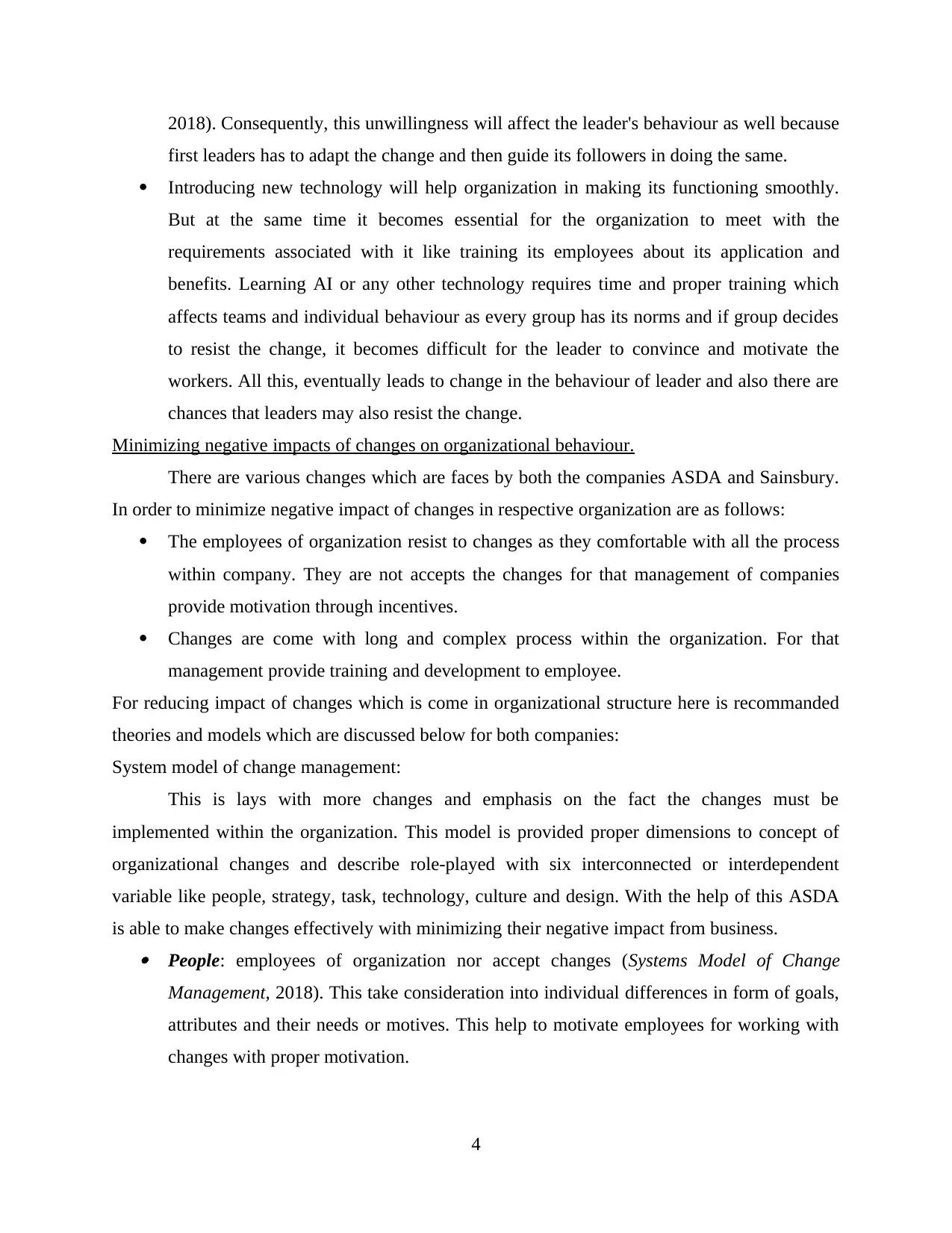
2018). Consequently, this unwillingness will affect the leader's behaviour as well because
first leaders has to adapt the change and then guide its followers in doing the same.
Introducing new technology will help organization in making its functioning smoothly.
But at the same time it becomes essential for the organization to meet with the
requirements associated with it like training its employees about its application and
benefits. Learning AI or any other technology requires time and proper training which
affects teams and individual behaviour as every group has its norms and if group decides
to resist the change, it becomes difficult for the leader to convince and motivate the
workers. All this, eventually leads to change in the behaviour of leader and also there are
chances that leaders may also resist the change.
Minimizing negative impacts of changes on organizational behaviour.
There are various changes which are faces by both the companies ASDA and Sainsbury.
In order to minimize negative impact of changes in respective organization are as follows:
The employees of organization resist to changes as they comfortable with all the process
within company. They are not accepts the changes for that management of companies
provide motivation through incentives.
Changes are come with long and complex process within the organization. For that
management provide training and development to employee.
For reducing impact of changes which is come in organizational structure here is recommanded
theories and models which are discussed below for both companies:
System model of change management:
This is lays with more changes and emphasis on the fact the changes must be
implemented within the organization. This model is provided proper dimensions to concept of
organizational changes and describe role-played with six interconnected or interdependent
variable like people, strategy, task, technology, culture and design. With the help of this ASDA
is able to make changes effectively with minimizing their negative impact from business. People: employees of organization nor accept changes (Systems Model of Change
Management, 2018). This take consideration into individual differences in form of goals,
attributes and their needs or motives. This help to motivate employees for working with
changes with proper motivation.
4
first leaders has to adapt the change and then guide its followers in doing the same.
Introducing new technology will help organization in making its functioning smoothly.
But at the same time it becomes essential for the organization to meet with the
requirements associated with it like training its employees about its application and
benefits. Learning AI or any other technology requires time and proper training which
affects teams and individual behaviour as every group has its norms and if group decides
to resist the change, it becomes difficult for the leader to convince and motivate the
workers. All this, eventually leads to change in the behaviour of leader and also there are
chances that leaders may also resist the change.
Minimizing negative impacts of changes on organizational behaviour.
There are various changes which are faces by both the companies ASDA and Sainsbury.
In order to minimize negative impact of changes in respective organization are as follows:
The employees of organization resist to changes as they comfortable with all the process
within company. They are not accepts the changes for that management of companies
provide motivation through incentives.
Changes are come with long and complex process within the organization. For that
management provide training and development to employee.
For reducing impact of changes which is come in organizational structure here is recommanded
theories and models which are discussed below for both companies:
System model of change management:
This is lays with more changes and emphasis on the fact the changes must be
implemented within the organization. This model is provided proper dimensions to concept of
organizational changes and describe role-played with six interconnected or interdependent
variable like people, strategy, task, technology, culture and design. With the help of this ASDA
is able to make changes effectively with minimizing their negative impact from business. People: employees of organization nor accept changes (Systems Model of Change
Management, 2018). This take consideration into individual differences in form of goals,
attributes and their needs or motives. This help to motivate employees for working with
changes with proper motivation.
4
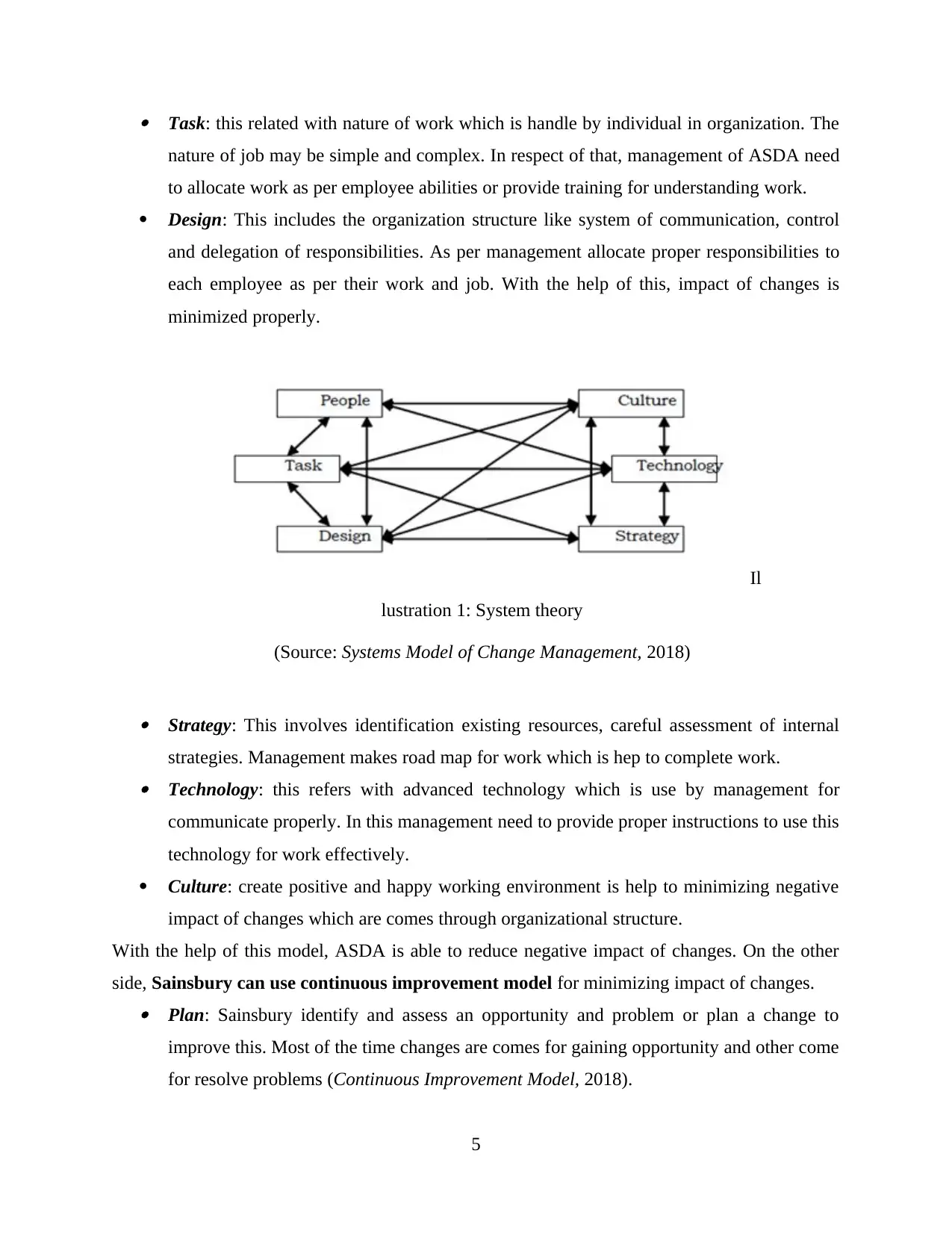
Task: this related with nature of work which is handle by individual in organization. The
nature of job may be simple and complex. In respect of that, management of ASDA need
to allocate work as per employee abilities or provide training for understanding work.
Design: This includes the organization structure like system of communication, control
and delegation of responsibilities. As per management allocate proper responsibilities to
each employee as per their work and job. With the help of this, impact of changes is
minimized properly.
Strategy: This involves identification existing resources, careful assessment of internal
strategies. Management makes road map for work which is hep to complete work. Technology: this refers with advanced technology which is use by management for
communicate properly. In this management need to provide proper instructions to use this
technology for work effectively.
Culture: create positive and happy working environment is help to minimizing negative
impact of changes which are comes through organizational structure.
With the help of this model, ASDA is able to reduce negative impact of changes. On the other
side, Sainsbury can use continuous improvement model for minimizing impact of changes. Plan: Sainsbury identify and assess an opportunity and problem or plan a change to
improve this. Most of the time changes are comes for gaining opportunity and other come
for resolve problems (Continuous Improvement Model, 2018).
5
Il
lustration 1: System theory
(Source: Systems Model of Change Management, 2018)
nature of job may be simple and complex. In respect of that, management of ASDA need
to allocate work as per employee abilities or provide training for understanding work.
Design: This includes the organization structure like system of communication, control
and delegation of responsibilities. As per management allocate proper responsibilities to
each employee as per their work and job. With the help of this, impact of changes is
minimized properly.
Strategy: This involves identification existing resources, careful assessment of internal
strategies. Management makes road map for work which is hep to complete work. Technology: this refers with advanced technology which is use by management for
communicate properly. In this management need to provide proper instructions to use this
technology for work effectively.
Culture: create positive and happy working environment is help to minimizing negative
impact of changes which are comes through organizational structure.
With the help of this model, ASDA is able to reduce negative impact of changes. On the other
side, Sainsbury can use continuous improvement model for minimizing impact of changes. Plan: Sainsbury identify and assess an opportunity and problem or plan a change to
improve this. Most of the time changes are comes for gaining opportunity and other come
for resolve problems (Continuous Improvement Model, 2018).
5
Il
lustration 1: System theory
(Source: Systems Model of Change Management, 2018)
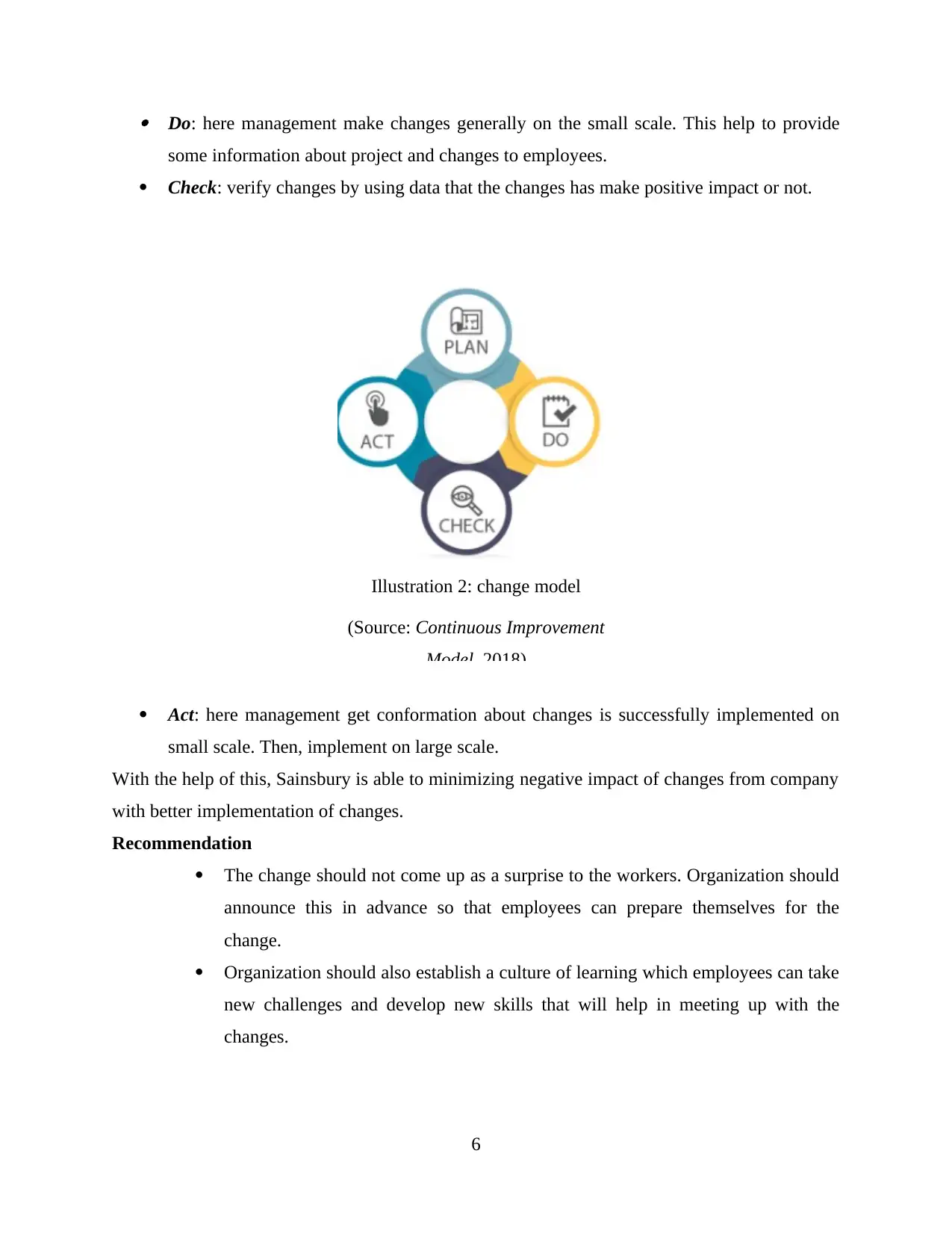
Do: here management make changes generally on the small scale. This help to provide
some information about project and changes to employees.
Check: verify changes by using data that the changes has make positive impact or not.
Act: here management get conformation about changes is successfully implemented on
small scale. Then, implement on large scale.
With the help of this, Sainsbury is able to minimizing negative impact of changes from company
with better implementation of changes.
Recommendation
The change should not come up as a surprise to the workers. Organization should
announce this in advance so that employees can prepare themselves for the
change.
Organization should also establish a culture of learning which employees can take
new challenges and develop new skills that will help in meeting up with the
changes.
6
Illustration 2: change model
(Source: Continuous Improvement
Model, 2018)
some information about project and changes to employees.
Check: verify changes by using data that the changes has make positive impact or not.
Act: here management get conformation about changes is successfully implemented on
small scale. Then, implement on large scale.
With the help of this, Sainsbury is able to minimizing negative impact of changes from company
with better implementation of changes.
Recommendation
The change should not come up as a surprise to the workers. Organization should
announce this in advance so that employees can prepare themselves for the
change.
Organization should also establish a culture of learning which employees can take
new challenges and develop new skills that will help in meeting up with the
changes.
6
Illustration 2: change model
(Source: Continuous Improvement
Model, 2018)
Paraphrase This Document
Need a fresh take? Get an instant paraphrase of this document with our AI Paraphraser
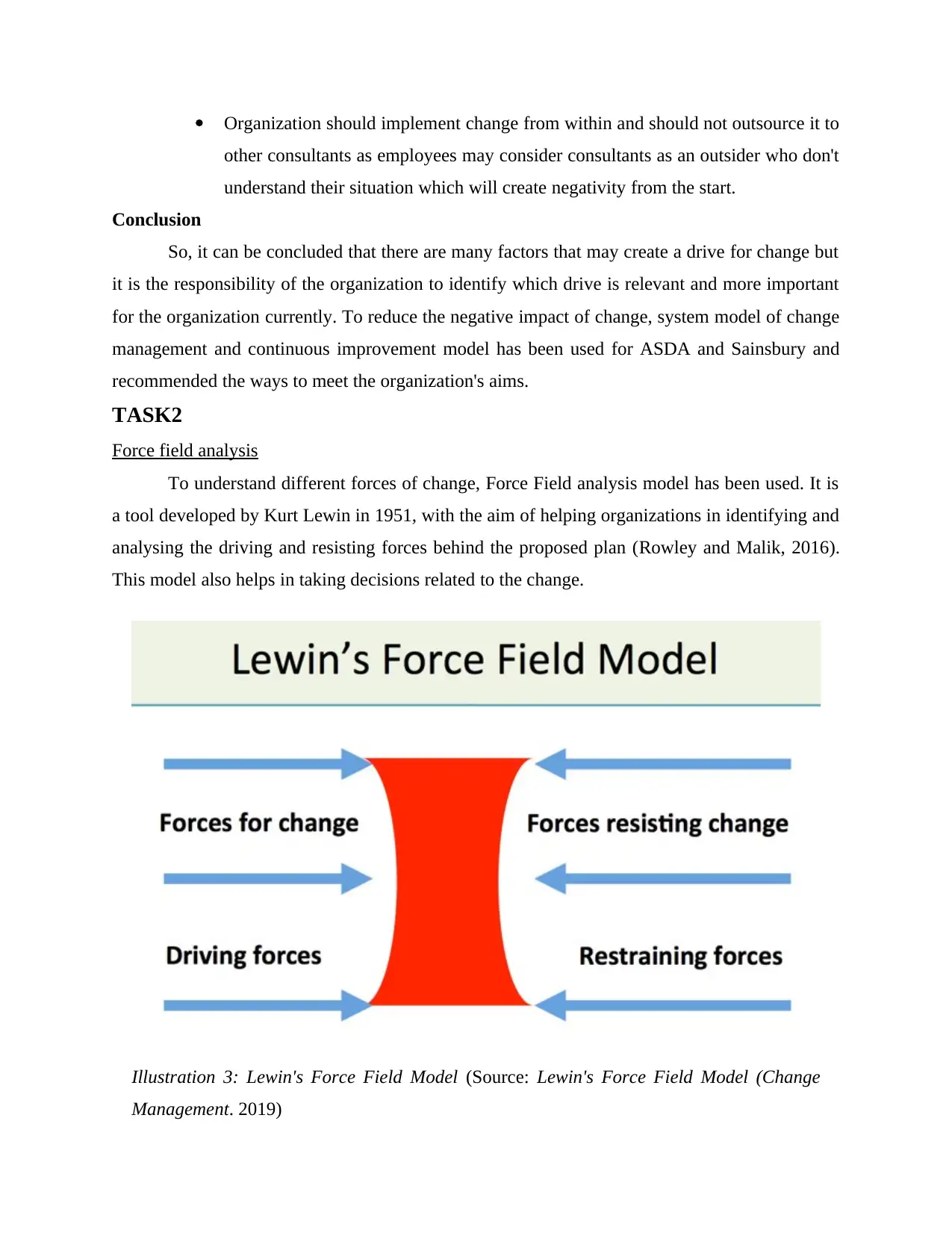
Organization should implement change from within and should not outsource it to
other consultants as employees may consider consultants as an outsider who don't
understand their situation which will create negativity from the start.
Conclusion
So, it can be concluded that there are many factors that may create a drive for change but
it is the responsibility of the organization to identify which drive is relevant and more important
for the organization currently. To reduce the negative impact of change, system model of change
management and continuous improvement model has been used for ASDA and Sainsbury and
recommended the ways to meet the organization's aims.
TASK2
Force field analysis
To understand different forces of change, Force Field analysis model has been used. It is
a tool developed by Kurt Lewin in 1951, with the aim of helping organizations in identifying and
analysing the driving and resisting forces behind the proposed plan (Rowley and Malik, 2016).
This model also helps in taking decisions related to the change.
7
Illustration 3: Lewin's Force Field Model (Source: Lewin's Force Field Model (Change
Management. 2019)
other consultants as employees may consider consultants as an outsider who don't
understand their situation which will create negativity from the start.
Conclusion
So, it can be concluded that there are many factors that may create a drive for change but
it is the responsibility of the organization to identify which drive is relevant and more important
for the organization currently. To reduce the negative impact of change, system model of change
management and continuous improvement model has been used for ASDA and Sainsbury and
recommended the ways to meet the organization's aims.
TASK2
Force field analysis
To understand different forces of change, Force Field analysis model has been used. It is
a tool developed by Kurt Lewin in 1951, with the aim of helping organizations in identifying and
analysing the driving and resisting forces behind the proposed plan (Rowley and Malik, 2016).
This model also helps in taking decisions related to the change.
7
Illustration 3: Lewin's Force Field Model (Source: Lewin's Force Field Model (Change
Management. 2019)
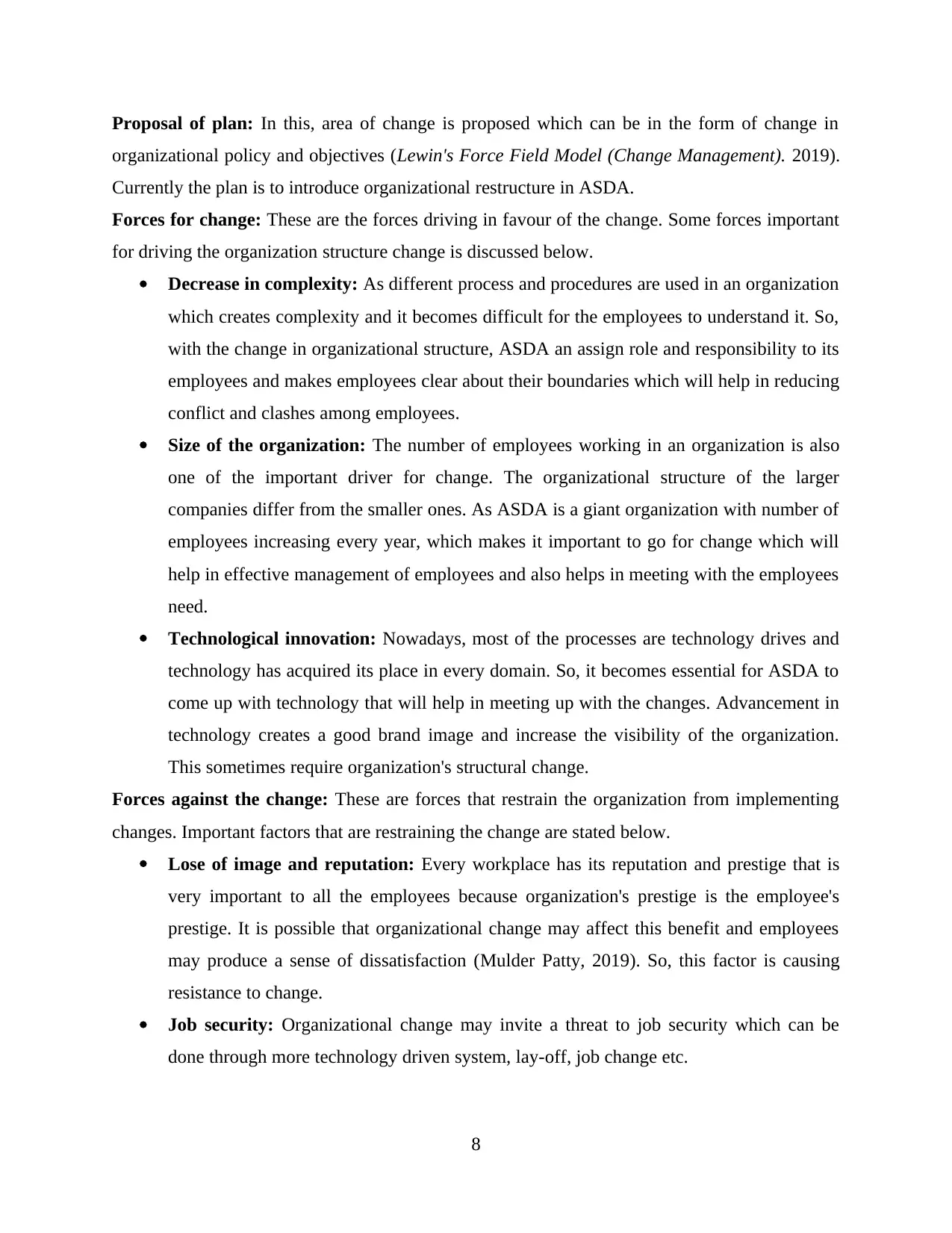
Proposal of plan: In this, area of change is proposed which can be in the form of change in
organizational policy and objectives (Lewin's Force Field Model (Change Management). 2019).
Currently the plan is to introduce organizational restructure in ASDA.
Forces for change: These are the forces driving in favour of the change. Some forces important
for driving the organization structure change is discussed below.
Decrease in complexity: As different process and procedures are used in an organization
which creates complexity and it becomes difficult for the employees to understand it. So,
with the change in organizational structure, ASDA an assign role and responsibility to its
employees and makes employees clear about their boundaries which will help in reducing
conflict and clashes among employees.
Size of the organization: The number of employees working in an organization is also
one of the important driver for change. The organizational structure of the larger
companies differ from the smaller ones. As ASDA is a giant organization with number of
employees increasing every year, which makes it important to go for change which will
help in effective management of employees and also helps in meeting with the employees
need.
Technological innovation: Nowadays, most of the processes are technology drives and
technology has acquired its place in every domain. So, it becomes essential for ASDA to
come up with technology that will help in meeting up with the changes. Advancement in
technology creates a good brand image and increase the visibility of the organization.
This sometimes require organization's structural change.
Forces against the change: These are forces that restrain the organization from implementing
changes. Important factors that are restraining the change are stated below.
Lose of image and reputation: Every workplace has its reputation and prestige that is
very important to all the employees because organization's prestige is the employee's
prestige. It is possible that organizational change may affect this benefit and employees
may produce a sense of dissatisfaction (Mulder Patty, 2019). So, this factor is causing
resistance to change.
Job security: Organizational change may invite a threat to job security which can be
done through more technology driven system, lay-off, job change etc.
8
organizational policy and objectives (Lewin's Force Field Model (Change Management). 2019).
Currently the plan is to introduce organizational restructure in ASDA.
Forces for change: These are the forces driving in favour of the change. Some forces important
for driving the organization structure change is discussed below.
Decrease in complexity: As different process and procedures are used in an organization
which creates complexity and it becomes difficult for the employees to understand it. So,
with the change in organizational structure, ASDA an assign role and responsibility to its
employees and makes employees clear about their boundaries which will help in reducing
conflict and clashes among employees.
Size of the organization: The number of employees working in an organization is also
one of the important driver for change. The organizational structure of the larger
companies differ from the smaller ones. As ASDA is a giant organization with number of
employees increasing every year, which makes it important to go for change which will
help in effective management of employees and also helps in meeting with the employees
need.
Technological innovation: Nowadays, most of the processes are technology drives and
technology has acquired its place in every domain. So, it becomes essential for ASDA to
come up with technology that will help in meeting up with the changes. Advancement in
technology creates a good brand image and increase the visibility of the organization.
This sometimes require organization's structural change.
Forces against the change: These are forces that restrain the organization from implementing
changes. Important factors that are restraining the change are stated below.
Lose of image and reputation: Every workplace has its reputation and prestige that is
very important to all the employees because organization's prestige is the employee's
prestige. It is possible that organizational change may affect this benefit and employees
may produce a sense of dissatisfaction (Mulder Patty, 2019). So, this factor is causing
resistance to change.
Job security: Organizational change may invite a threat to job security which can be
done through more technology driven system, lay-off, job change etc.
8
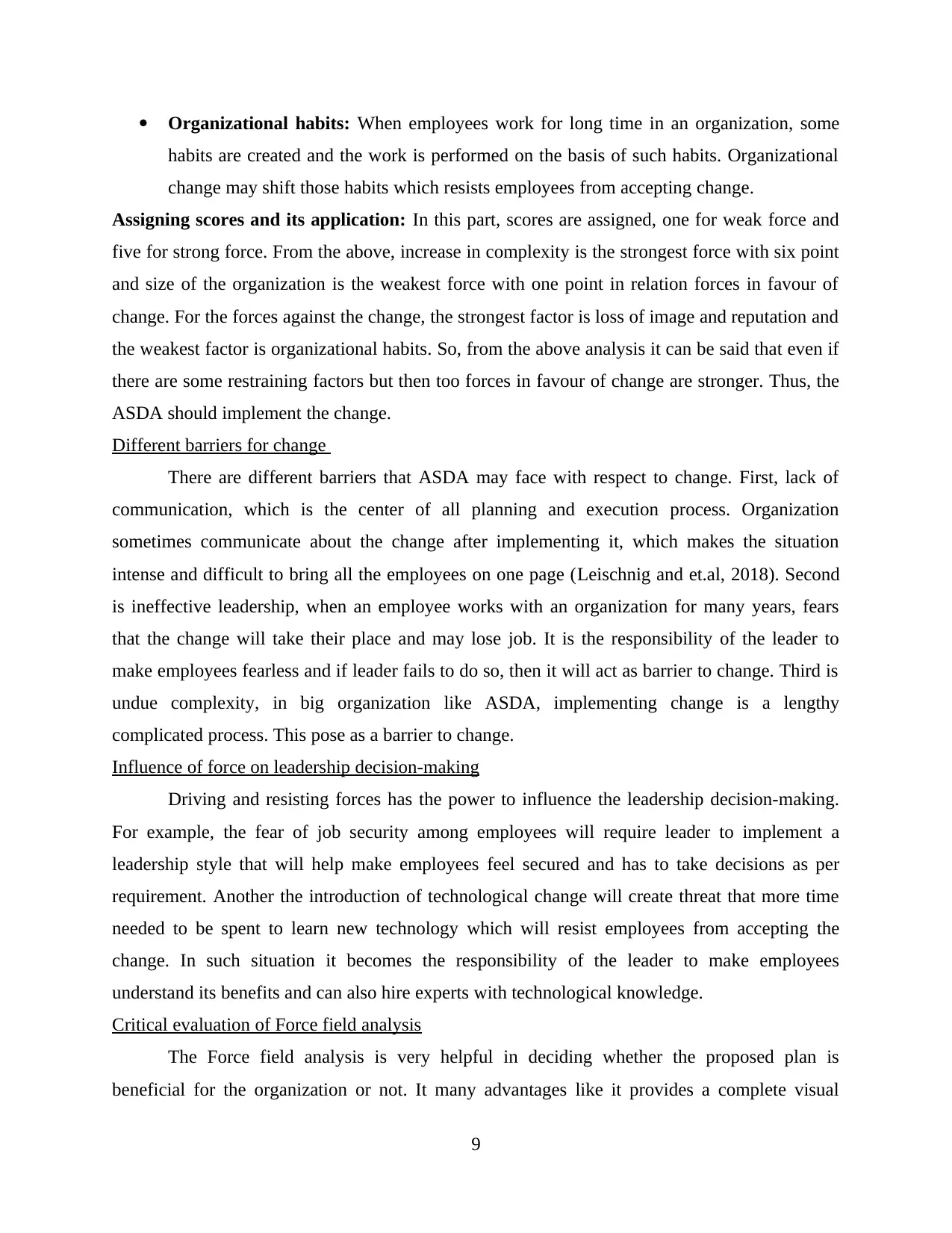
Organizational habits: When employees work for long time in an organization, some
habits are created and the work is performed on the basis of such habits. Organizational
change may shift those habits which resists employees from accepting change.
Assigning scores and its application: In this part, scores are assigned, one for weak force and
five for strong force. From the above, increase in complexity is the strongest force with six point
and size of the organization is the weakest force with one point in relation forces in favour of
change. For the forces against the change, the strongest factor is loss of image and reputation and
the weakest factor is organizational habits. So, from the above analysis it can be said that even if
there are some restraining factors but then too forces in favour of change are stronger. Thus, the
ASDA should implement the change.
Different barriers for change
There are different barriers that ASDA may face with respect to change. First, lack of
communication, which is the center of all planning and execution process. Organization
sometimes communicate about the change after implementing it, which makes the situation
intense and difficult to bring all the employees on one page (Leischnig and et.al, 2018). Second
is ineffective leadership, when an employee works with an organization for many years, fears
that the change will take their place and may lose job. It is the responsibility of the leader to
make employees fearless and if leader fails to do so, then it will act as barrier to change. Third is
undue complexity, in big organization like ASDA, implementing change is a lengthy
complicated process. This pose as a barrier to change.
Influence of force on leadership decision-making
Driving and resisting forces has the power to influence the leadership decision-making.
For example, the fear of job security among employees will require leader to implement a
leadership style that will help make employees feel secured and has to take decisions as per
requirement. Another the introduction of technological change will create threat that more time
needed to be spent to learn new technology which will resist employees from accepting the
change. In such situation it becomes the responsibility of the leader to make employees
understand its benefits and can also hire experts with technological knowledge.
Critical evaluation of Force field analysis
The Force field analysis is very helpful in deciding whether the proposed plan is
beneficial for the organization or not. It many advantages like it provides a complete visual
9
habits are created and the work is performed on the basis of such habits. Organizational
change may shift those habits which resists employees from accepting change.
Assigning scores and its application: In this part, scores are assigned, one for weak force and
five for strong force. From the above, increase in complexity is the strongest force with six point
and size of the organization is the weakest force with one point in relation forces in favour of
change. For the forces against the change, the strongest factor is loss of image and reputation and
the weakest factor is organizational habits. So, from the above analysis it can be said that even if
there are some restraining factors but then too forces in favour of change are stronger. Thus, the
ASDA should implement the change.
Different barriers for change
There are different barriers that ASDA may face with respect to change. First, lack of
communication, which is the center of all planning and execution process. Organization
sometimes communicate about the change after implementing it, which makes the situation
intense and difficult to bring all the employees on one page (Leischnig and et.al, 2018). Second
is ineffective leadership, when an employee works with an organization for many years, fears
that the change will take their place and may lose job. It is the responsibility of the leader to
make employees fearless and if leader fails to do so, then it will act as barrier to change. Third is
undue complexity, in big organization like ASDA, implementing change is a lengthy
complicated process. This pose as a barrier to change.
Influence of force on leadership decision-making
Driving and resisting forces has the power to influence the leadership decision-making.
For example, the fear of job security among employees will require leader to implement a
leadership style that will help make employees feel secured and has to take decisions as per
requirement. Another the introduction of technological change will create threat that more time
needed to be spent to learn new technology which will resist employees from accepting the
change. In such situation it becomes the responsibility of the leader to make employees
understand its benefits and can also hire experts with technological knowledge.
Critical evaluation of Force field analysis
The Force field analysis is very helpful in deciding whether the proposed plan is
beneficial for the organization or not. It many advantages like it provides a complete visual
9
Secure Best Marks with AI Grader
Need help grading? Try our AI Grader for instant feedback on your assignments.
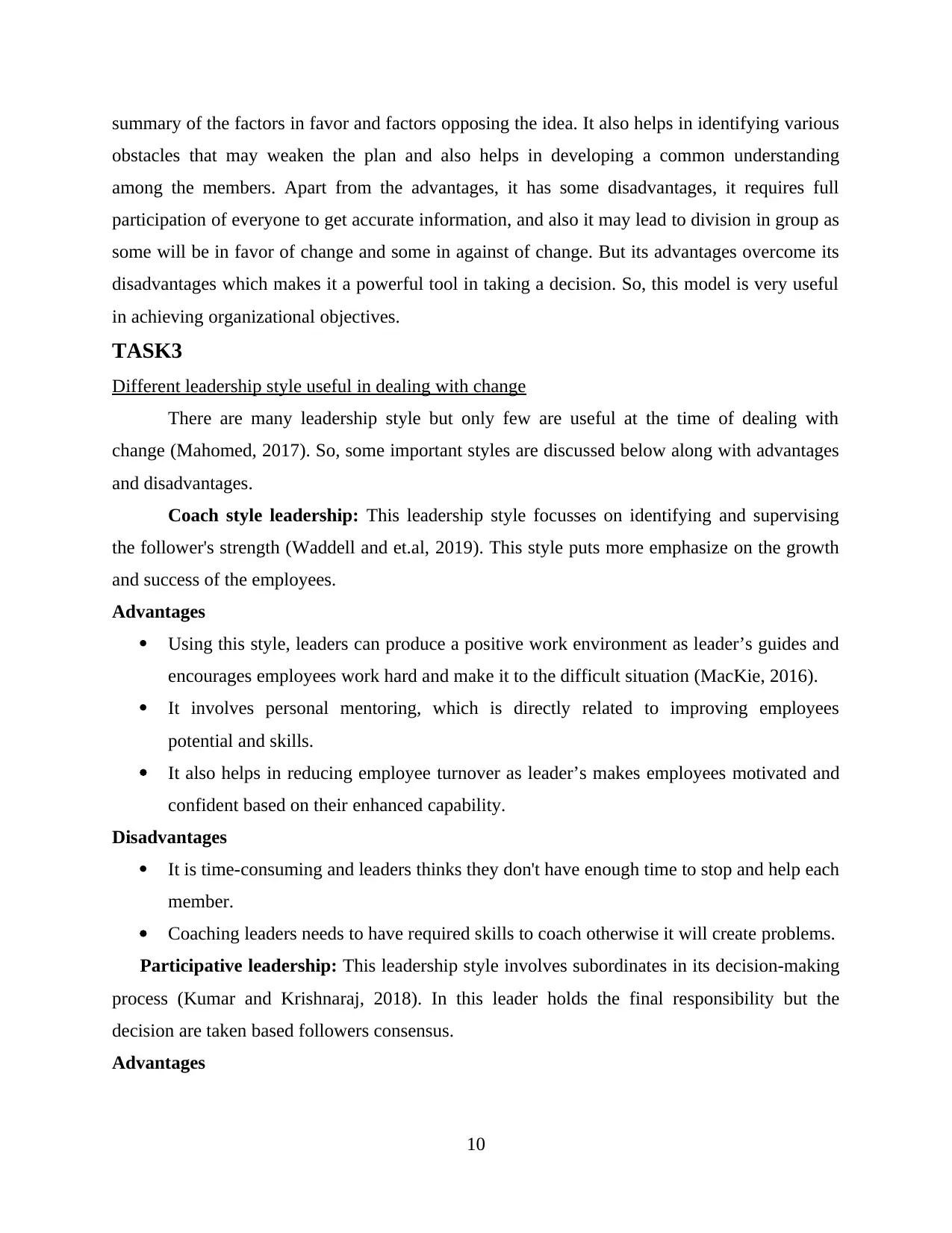
summary of the factors in favor and factors opposing the idea. It also helps in identifying various
obstacles that may weaken the plan and also helps in developing a common understanding
among the members. Apart from the advantages, it has some disadvantages, it requires full
participation of everyone to get accurate information, and also it may lead to division in group as
some will be in favor of change and some in against of change. But its advantages overcome its
disadvantages which makes it a powerful tool in taking a decision. So, this model is very useful
in achieving organizational objectives.
TASK3
Different leadership style useful in dealing with change
There are many leadership style but only few are useful at the time of dealing with
change (Mahomed, 2017). So, some important styles are discussed below along with advantages
and disadvantages.
Coach style leadership: This leadership style focusses on identifying and supervising
the follower's strength (Waddell and et.al, 2019). This style puts more emphasize on the growth
and success of the employees.
Advantages
Using this style, leaders can produce a positive work environment as leader’s guides and
encourages employees work hard and make it to the difficult situation (MacKie, 2016).
It involves personal mentoring, which is directly related to improving employees
potential and skills.
It also helps in reducing employee turnover as leader’s makes employees motivated and
confident based on their enhanced capability.
Disadvantages
It is time-consuming and leaders thinks they don't have enough time to stop and help each
member.
Coaching leaders needs to have required skills to coach otherwise it will create problems.
Participative leadership: This leadership style involves subordinates in its decision-making
process (Kumar and Krishnaraj, 2018). In this leader holds the final responsibility but the
decision are taken based followers consensus.
Advantages
10
obstacles that may weaken the plan and also helps in developing a common understanding
among the members. Apart from the advantages, it has some disadvantages, it requires full
participation of everyone to get accurate information, and also it may lead to division in group as
some will be in favor of change and some in against of change. But its advantages overcome its
disadvantages which makes it a powerful tool in taking a decision. So, this model is very useful
in achieving organizational objectives.
TASK3
Different leadership style useful in dealing with change
There are many leadership style but only few are useful at the time of dealing with
change (Mahomed, 2017). So, some important styles are discussed below along with advantages
and disadvantages.
Coach style leadership: This leadership style focusses on identifying and supervising
the follower's strength (Waddell and et.al, 2019). This style puts more emphasize on the growth
and success of the employees.
Advantages
Using this style, leaders can produce a positive work environment as leader’s guides and
encourages employees work hard and make it to the difficult situation (MacKie, 2016).
It involves personal mentoring, which is directly related to improving employees
potential and skills.
It also helps in reducing employee turnover as leader’s makes employees motivated and
confident based on their enhanced capability.
Disadvantages
It is time-consuming and leaders thinks they don't have enough time to stop and help each
member.
Coaching leaders needs to have required skills to coach otherwise it will create problems.
Participative leadership: This leadership style involves subordinates in its decision-making
process (Kumar and Krishnaraj, 2018). In this leader holds the final responsibility but the
decision are taken based followers consensus.
Advantages
10
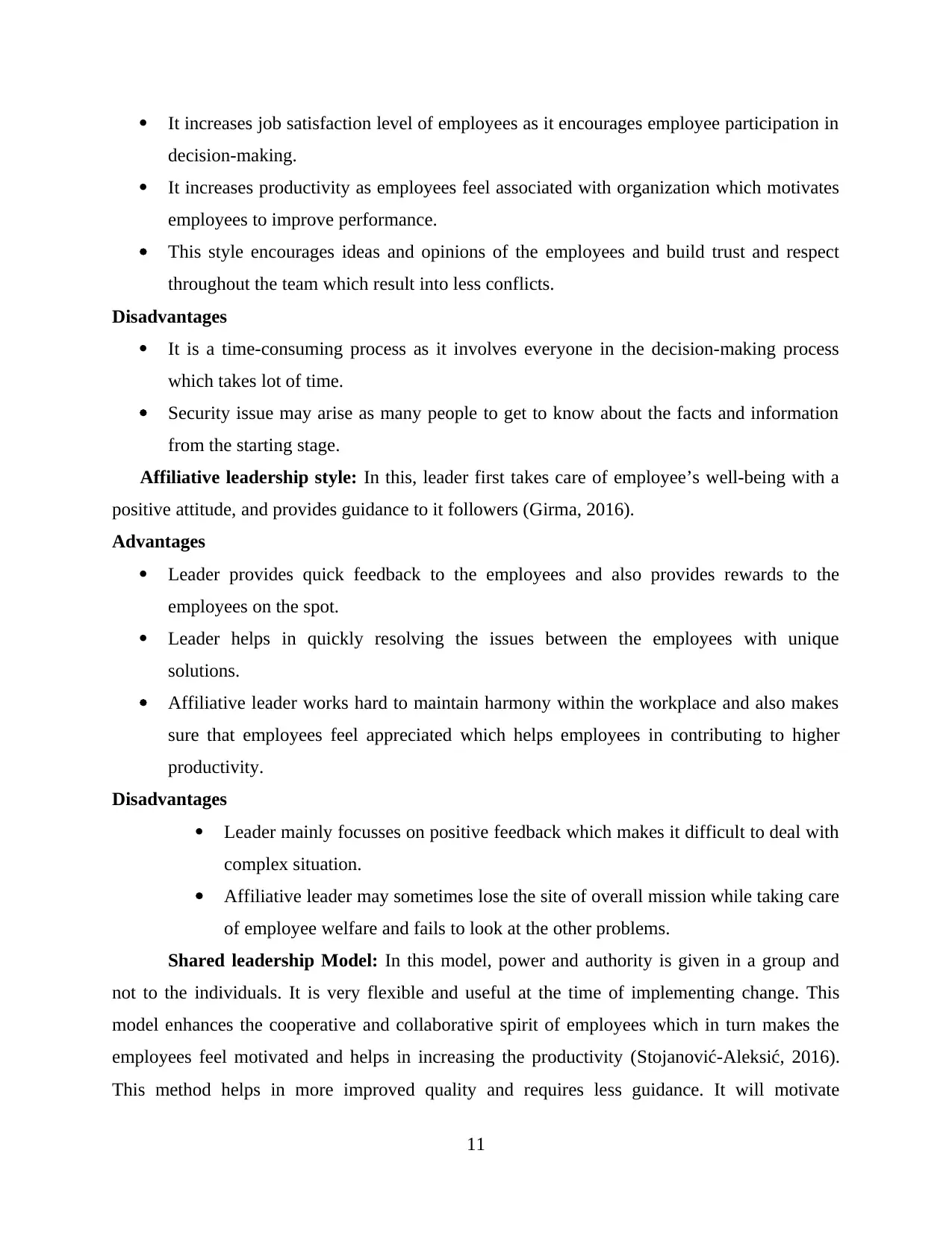
It increases job satisfaction level of employees as it encourages employee participation in
decision-making.
It increases productivity as employees feel associated with organization which motivates
employees to improve performance.
This style encourages ideas and opinions of the employees and build trust and respect
throughout the team which result into less conflicts.
Disadvantages
It is a time-consuming process as it involves everyone in the decision-making process
which takes lot of time.
Security issue may arise as many people to get to know about the facts and information
from the starting stage.
Affiliative leadership style: In this, leader first takes care of employee’s well-being with a
positive attitude, and provides guidance to it followers (Girma, 2016).
Advantages
Leader provides quick feedback to the employees and also provides rewards to the
employees on the spot.
Leader helps in quickly resolving the issues between the employees with unique
solutions.
Affiliative leader works hard to maintain harmony within the workplace and also makes
sure that employees feel appreciated which helps employees in contributing to higher
productivity.
Disadvantages
Leader mainly focusses on positive feedback which makes it difficult to deal with
complex situation.
Affiliative leader may sometimes lose the site of overall mission while taking care
of employee welfare and fails to look at the other problems.
Shared leadership Model: In this model, power and authority is given in a group and
not to the individuals. It is very flexible and useful at the time of implementing change. This
model enhances the cooperative and collaborative spirit of employees which in turn makes the
employees feel motivated and helps in increasing the productivity (Stojanović-Aleksić, 2016).
This method helps in more improved quality and requires less guidance. It will motivate
11
decision-making.
It increases productivity as employees feel associated with organization which motivates
employees to improve performance.
This style encourages ideas and opinions of the employees and build trust and respect
throughout the team which result into less conflicts.
Disadvantages
It is a time-consuming process as it involves everyone in the decision-making process
which takes lot of time.
Security issue may arise as many people to get to know about the facts and information
from the starting stage.
Affiliative leadership style: In this, leader first takes care of employee’s well-being with a
positive attitude, and provides guidance to it followers (Girma, 2016).
Advantages
Leader provides quick feedback to the employees and also provides rewards to the
employees on the spot.
Leader helps in quickly resolving the issues between the employees with unique
solutions.
Affiliative leader works hard to maintain harmony within the workplace and also makes
sure that employees feel appreciated which helps employees in contributing to higher
productivity.
Disadvantages
Leader mainly focusses on positive feedback which makes it difficult to deal with
complex situation.
Affiliative leader may sometimes lose the site of overall mission while taking care
of employee welfare and fails to look at the other problems.
Shared leadership Model: In this model, power and authority is given in a group and
not to the individuals. It is very flexible and useful at the time of implementing change. This
model enhances the cooperative and collaborative spirit of employees which in turn makes the
employees feel motivated and helps in increasing the productivity (Stojanović-Aleksić, 2016).
This method helps in more improved quality and requires less guidance. It will motivate
11
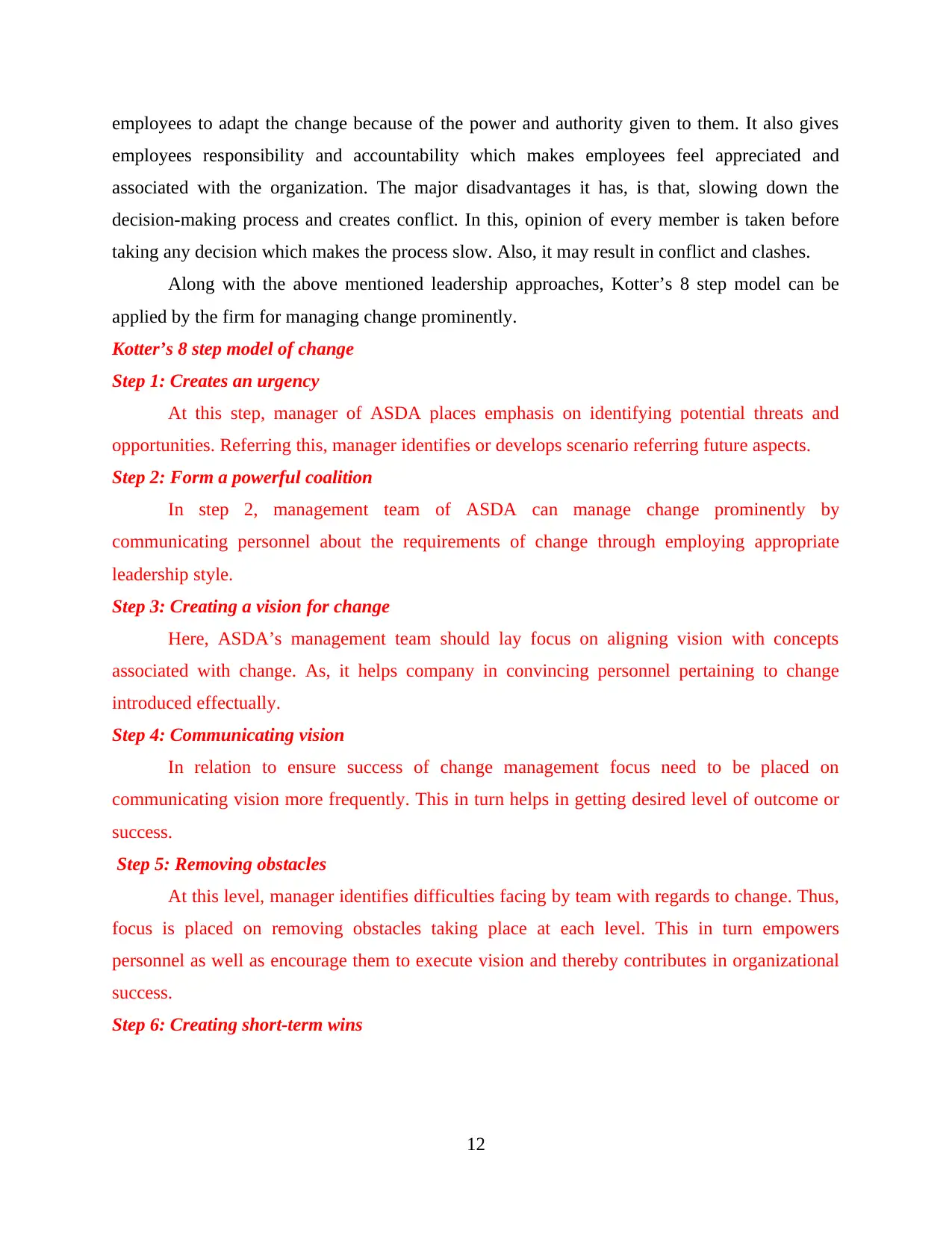
employees to adapt the change because of the power and authority given to them. It also gives
employees responsibility and accountability which makes employees feel appreciated and
associated with the organization. The major disadvantages it has, is that, slowing down the
decision-making process and creates conflict. In this, opinion of every member is taken before
taking any decision which makes the process slow. Also, it may result in conflict and clashes.
Along with the above mentioned leadership approaches, Kotter’s 8 step model can be
applied by the firm for managing change prominently.
Kotter’s 8 step model of change
Step 1: Creates an urgency
At this step, manager of ASDA places emphasis on identifying potential threats and
opportunities. Referring this, manager identifies or develops scenario referring future aspects.
Step 2: Form a powerful coalition
In step 2, management team of ASDA can manage change prominently by
communicating personnel about the requirements of change through employing appropriate
leadership style.
Step 3: Creating a vision for change
Here, ASDA’s management team should lay focus on aligning vision with concepts
associated with change. As, it helps company in convincing personnel pertaining to change
introduced effectually.
Step 4: Communicating vision
In relation to ensure success of change management focus need to be placed on
communicating vision more frequently. This in turn helps in getting desired level of outcome or
success.
Step 5: Removing obstacles
At this level, manager identifies difficulties facing by team with regards to change. Thus,
focus is placed on removing obstacles taking place at each level. This in turn empowers
personnel as well as encourage them to execute vision and thereby contributes in organizational
success.
Step 6: Creating short-term wins
12
employees responsibility and accountability which makes employees feel appreciated and
associated with the organization. The major disadvantages it has, is that, slowing down the
decision-making process and creates conflict. In this, opinion of every member is taken before
taking any decision which makes the process slow. Also, it may result in conflict and clashes.
Along with the above mentioned leadership approaches, Kotter’s 8 step model can be
applied by the firm for managing change prominently.
Kotter’s 8 step model of change
Step 1: Creates an urgency
At this step, manager of ASDA places emphasis on identifying potential threats and
opportunities. Referring this, manager identifies or develops scenario referring future aspects.
Step 2: Form a powerful coalition
In step 2, management team of ASDA can manage change prominently by
communicating personnel about the requirements of change through employing appropriate
leadership style.
Step 3: Creating a vision for change
Here, ASDA’s management team should lay focus on aligning vision with concepts
associated with change. As, it helps company in convincing personnel pertaining to change
introduced effectually.
Step 4: Communicating vision
In relation to ensure success of change management focus need to be placed on
communicating vision more frequently. This in turn helps in getting desired level of outcome or
success.
Step 5: Removing obstacles
At this level, manager identifies difficulties facing by team with regards to change. Thus,
focus is placed on removing obstacles taking place at each level. This in turn empowers
personnel as well as encourage them to execute vision and thereby contributes in organizational
success.
Step 6: Creating short-term wins
12
Paraphrase This Document
Need a fresh take? Get an instant paraphrase of this document with our AI Paraphraser
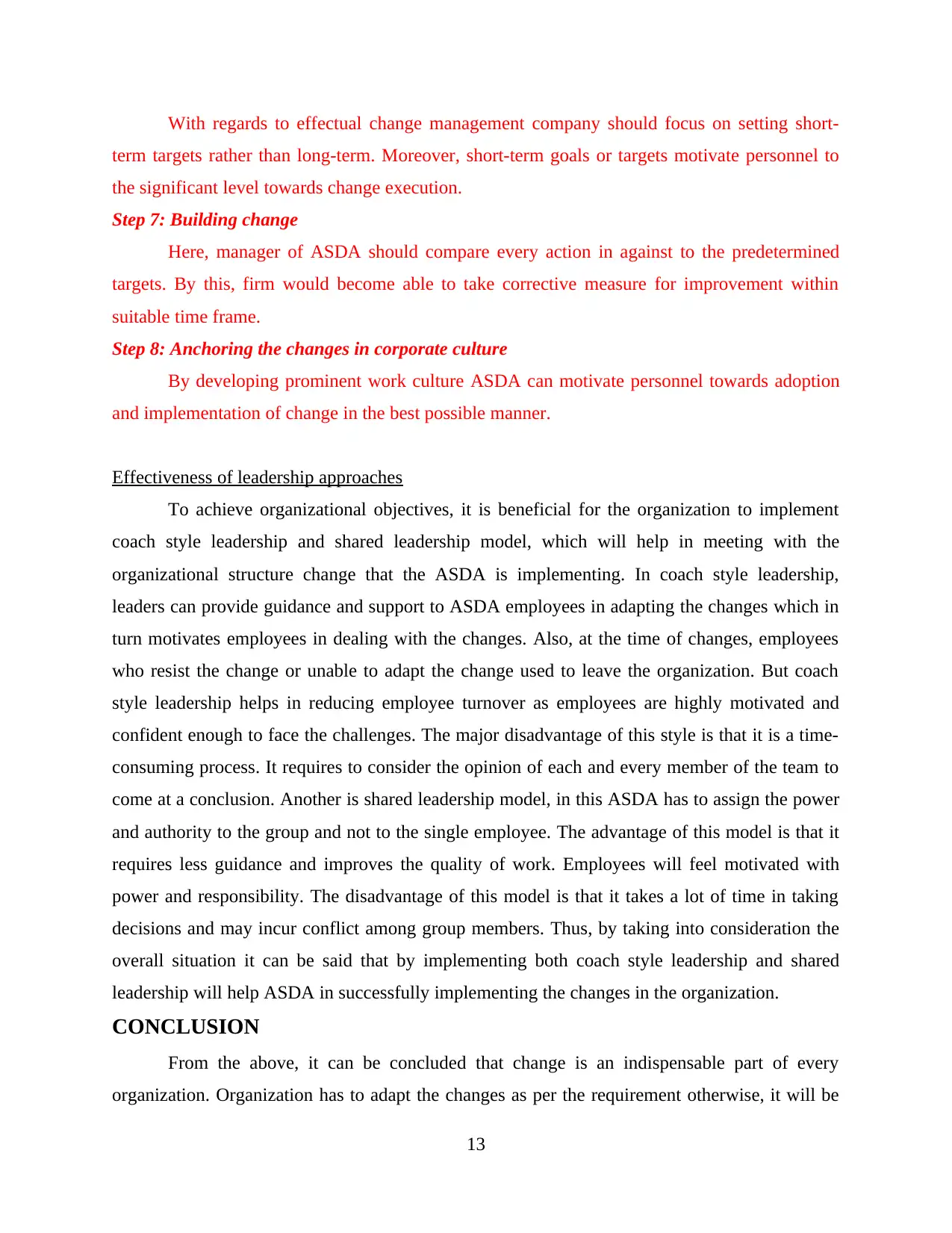
With regards to effectual change management company should focus on setting short-
term targets rather than long-term. Moreover, short-term goals or targets motivate personnel to
the significant level towards change execution.
Step 7: Building change
Here, manager of ASDA should compare every action in against to the predetermined
targets. By this, firm would become able to take corrective measure for improvement within
suitable time frame.
Step 8: Anchoring the changes in corporate culture
By developing prominent work culture ASDA can motivate personnel towards adoption
and implementation of change in the best possible manner.
Effectiveness of leadership approaches
To achieve organizational objectives, it is beneficial for the organization to implement
coach style leadership and shared leadership model, which will help in meeting with the
organizational structure change that the ASDA is implementing. In coach style leadership,
leaders can provide guidance and support to ASDA employees in adapting the changes which in
turn motivates employees in dealing with the changes. Also, at the time of changes, employees
who resist the change or unable to adapt the change used to leave the organization. But coach
style leadership helps in reducing employee turnover as employees are highly motivated and
confident enough to face the challenges. The major disadvantage of this style is that it is a time-
consuming process. It requires to consider the opinion of each and every member of the team to
come at a conclusion. Another is shared leadership model, in this ASDA has to assign the power
and authority to the group and not to the single employee. The advantage of this model is that it
requires less guidance and improves the quality of work. Employees will feel motivated with
power and responsibility. The disadvantage of this model is that it takes a lot of time in taking
decisions and may incur conflict among group members. Thus, by taking into consideration the
overall situation it can be said that by implementing both coach style leadership and shared
leadership will help ASDA in successfully implementing the changes in the organization.
CONCLUSION
From the above, it can be concluded that change is an indispensable part of every
organization. Organization has to adapt the changes as per the requirement otherwise, it will be
13
term targets rather than long-term. Moreover, short-term goals or targets motivate personnel to
the significant level towards change execution.
Step 7: Building change
Here, manager of ASDA should compare every action in against to the predetermined
targets. By this, firm would become able to take corrective measure for improvement within
suitable time frame.
Step 8: Anchoring the changes in corporate culture
By developing prominent work culture ASDA can motivate personnel towards adoption
and implementation of change in the best possible manner.
Effectiveness of leadership approaches
To achieve organizational objectives, it is beneficial for the organization to implement
coach style leadership and shared leadership model, which will help in meeting with the
organizational structure change that the ASDA is implementing. In coach style leadership,
leaders can provide guidance and support to ASDA employees in adapting the changes which in
turn motivates employees in dealing with the changes. Also, at the time of changes, employees
who resist the change or unable to adapt the change used to leave the organization. But coach
style leadership helps in reducing employee turnover as employees are highly motivated and
confident enough to face the challenges. The major disadvantage of this style is that it is a time-
consuming process. It requires to consider the opinion of each and every member of the team to
come at a conclusion. Another is shared leadership model, in this ASDA has to assign the power
and authority to the group and not to the single employee. The advantage of this model is that it
requires less guidance and improves the quality of work. Employees will feel motivated with
power and responsibility. The disadvantage of this model is that it takes a lot of time in taking
decisions and may incur conflict among group members. Thus, by taking into consideration the
overall situation it can be said that by implementing both coach style leadership and shared
leadership will help ASDA in successfully implementing the changes in the organization.
CONCLUSION
From the above, it can be concluded that change is an indispensable part of every
organization. Organization has to adapt the changes as per the requirement otherwise, it will be
13
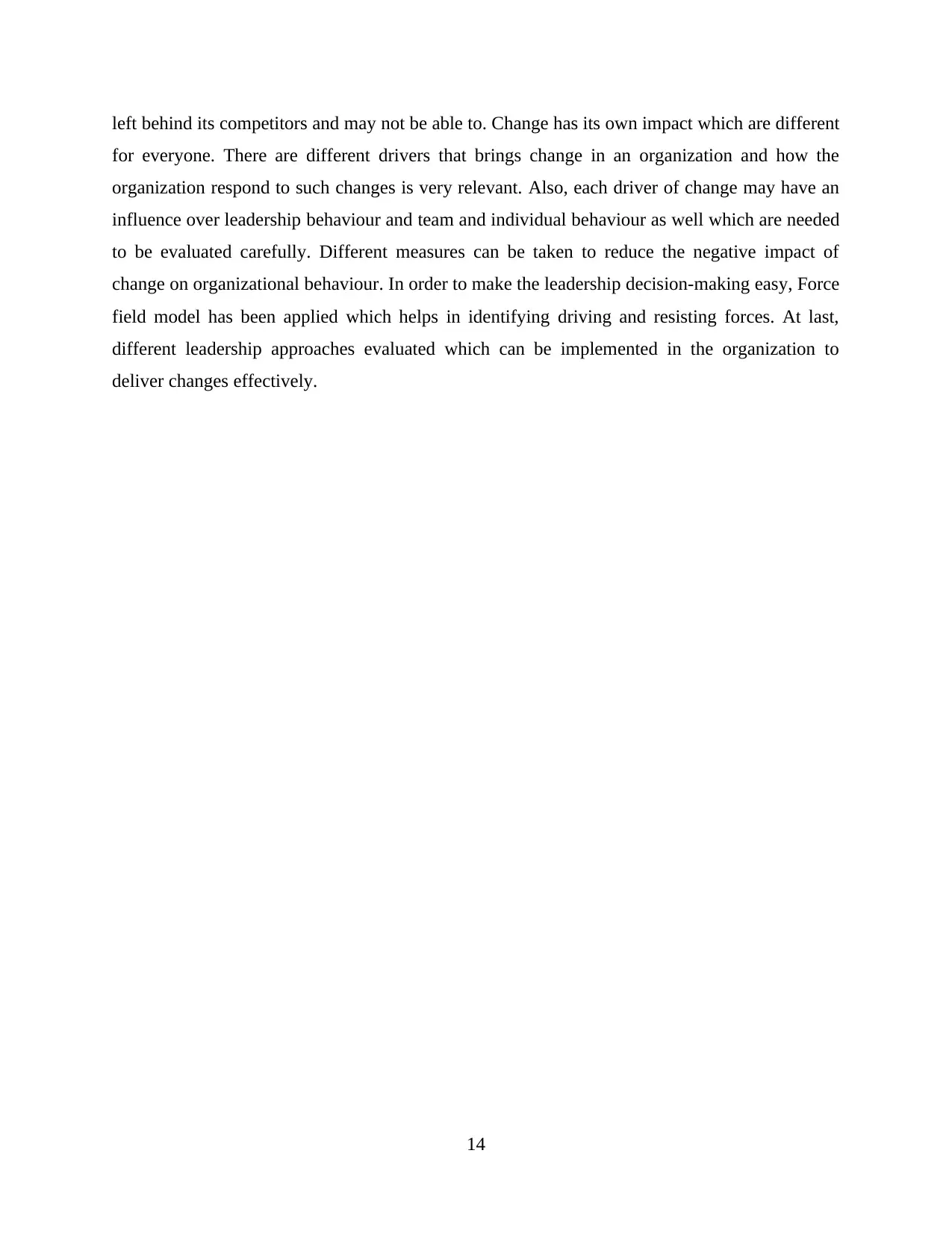
left behind its competitors and may not be able to. Change has its own impact which are different
for everyone. There are different drivers that brings change in an organization and how the
organization respond to such changes is very relevant. Also, each driver of change may have an
influence over leadership behaviour and team and individual behaviour as well which are needed
to be evaluated carefully. Different measures can be taken to reduce the negative impact of
change on organizational behaviour. In order to make the leadership decision-making easy, Force
field model has been applied which helps in identifying driving and resisting forces. At last,
different leadership approaches evaluated which can be implemented in the organization to
deliver changes effectively.
14
for everyone. There are different drivers that brings change in an organization and how the
organization respond to such changes is very relevant. Also, each driver of change may have an
influence over leadership behaviour and team and individual behaviour as well which are needed
to be evaluated carefully. Different measures can be taken to reduce the negative impact of
change on organizational behaviour. In order to make the leadership decision-making easy, Force
field model has been applied which helps in identifying driving and resisting forces. At last,
different leadership approaches evaluated which can be implemented in the organization to
deliver changes effectively.
14
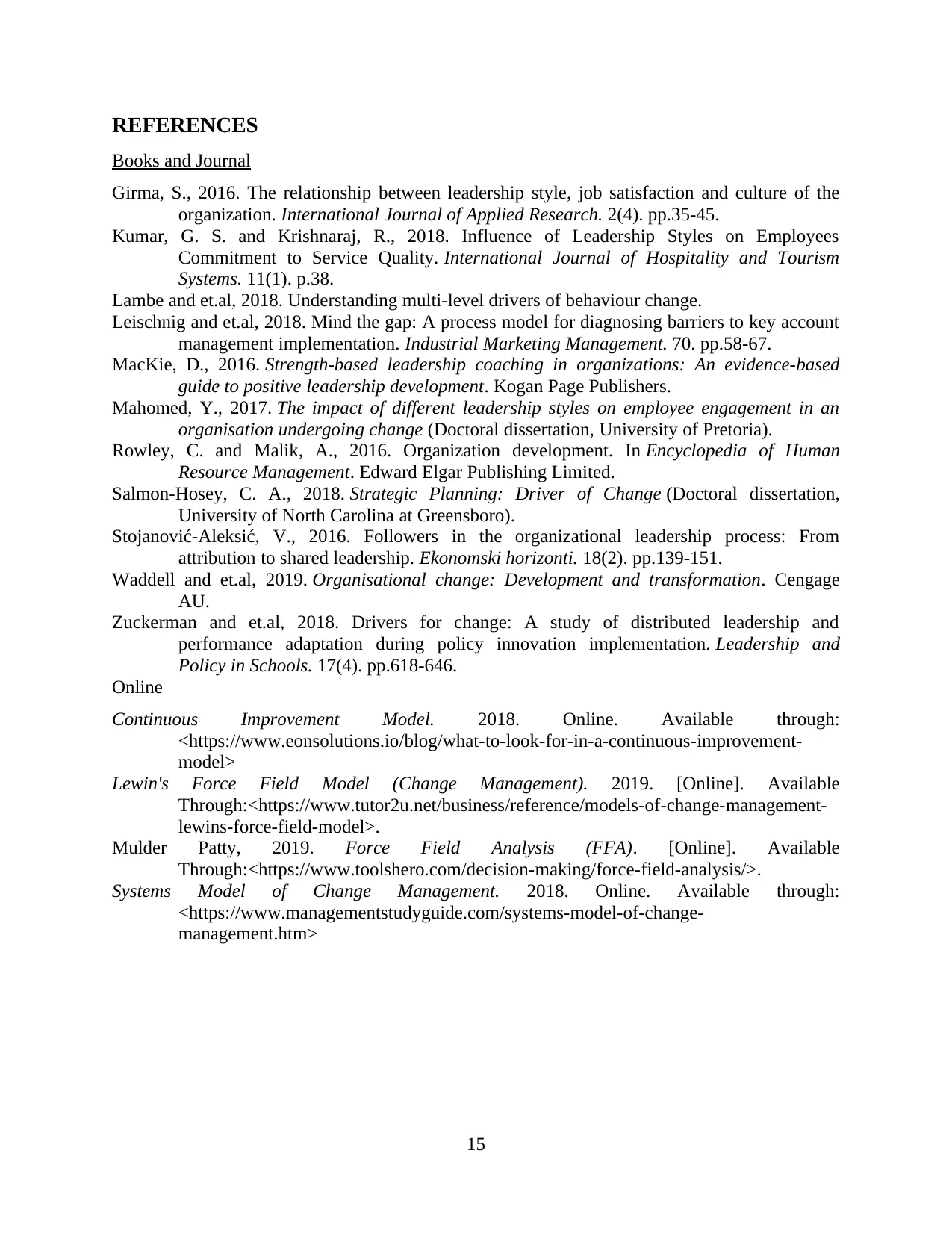
REFERENCES
Books and Journal
Girma, S., 2016. The relationship between leadership style, job satisfaction and culture of the
organization. International Journal of Applied Research. 2(4). pp.35-45.
Kumar, G. S. and Krishnaraj, R., 2018. Influence of Leadership Styles on Employees
Commitment to Service Quality. International Journal of Hospitality and Tourism
Systems. 11(1). p.38.
Lambe and et.al, 2018. Understanding multi-level drivers of behaviour change.
Leischnig and et.al, 2018. Mind the gap: A process model for diagnosing barriers to key account
management implementation. Industrial Marketing Management. 70. pp.58-67.
MacKie, D., 2016. Strength-based leadership coaching in organizations: An evidence-based
guide to positive leadership development. Kogan Page Publishers.
Mahomed, Y., 2017. The impact of different leadership styles on employee engagement in an
organisation undergoing change (Doctoral dissertation, University of Pretoria).
Rowley, C. and Malik, A., 2016. Organization development. In Encyclopedia of Human
Resource Management. Edward Elgar Publishing Limited.
Salmon-Hosey, C. A., 2018. Strategic Planning: Driver of Change (Doctoral dissertation,
University of North Carolina at Greensboro).
Stojanović-Aleksić, V., 2016. Followers in the organizational leadership process: From
attribution to shared leadership. Ekonomski horizonti. 18(2). pp.139-151.
Waddell and et.al, 2019. Organisational change: Development and transformation. Cengage
AU.
Zuckerman and et.al, 2018. Drivers for change: A study of distributed leadership and
performance adaptation during policy innovation implementation. Leadership and
Policy in Schools. 17(4). pp.618-646.
Online
Continuous Improvement Model. 2018. Online. Available through:
<https://www.eonsolutions.io/blog/what-to-look-for-in-a-continuous-improvement-
model>
Lewin's Force Field Model (Change Management). 2019. [Online]. Available
Through:<https://www.tutor2u.net/business/reference/models-of-change-management-
lewins-force-field-model>.
Mulder Patty, 2019. Force Field Analysis (FFA). [Online]. Available
Through:<https://www.toolshero.com/decision-making/force-field-analysis/>.
Systems Model of Change Management. 2018. Online. Available through:
<https://www.managementstudyguide.com/systems-model-of-change-
management.htm>
15
Books and Journal
Girma, S., 2016. The relationship between leadership style, job satisfaction and culture of the
organization. International Journal of Applied Research. 2(4). pp.35-45.
Kumar, G. S. and Krishnaraj, R., 2018. Influence of Leadership Styles on Employees
Commitment to Service Quality. International Journal of Hospitality and Tourism
Systems. 11(1). p.38.
Lambe and et.al, 2018. Understanding multi-level drivers of behaviour change.
Leischnig and et.al, 2018. Mind the gap: A process model for diagnosing barriers to key account
management implementation. Industrial Marketing Management. 70. pp.58-67.
MacKie, D., 2016. Strength-based leadership coaching in organizations: An evidence-based
guide to positive leadership development. Kogan Page Publishers.
Mahomed, Y., 2017. The impact of different leadership styles on employee engagement in an
organisation undergoing change (Doctoral dissertation, University of Pretoria).
Rowley, C. and Malik, A., 2016. Organization development. In Encyclopedia of Human
Resource Management. Edward Elgar Publishing Limited.
Salmon-Hosey, C. A., 2018. Strategic Planning: Driver of Change (Doctoral dissertation,
University of North Carolina at Greensboro).
Stojanović-Aleksić, V., 2016. Followers in the organizational leadership process: From
attribution to shared leadership. Ekonomski horizonti. 18(2). pp.139-151.
Waddell and et.al, 2019. Organisational change: Development and transformation. Cengage
AU.
Zuckerman and et.al, 2018. Drivers for change: A study of distributed leadership and
performance adaptation during policy innovation implementation. Leadership and
Policy in Schools. 17(4). pp.618-646.
Online
Continuous Improvement Model. 2018. Online. Available through:
<https://www.eonsolutions.io/blog/what-to-look-for-in-a-continuous-improvement-
model>
Lewin's Force Field Model (Change Management). 2019. [Online]. Available
Through:<https://www.tutor2u.net/business/reference/models-of-change-management-
lewins-force-field-model>.
Mulder Patty, 2019. Force Field Analysis (FFA). [Online]. Available
Through:<https://www.toolshero.com/decision-making/force-field-analysis/>.
Systems Model of Change Management. 2018. Online. Available through:
<https://www.managementstudyguide.com/systems-model-of-change-
management.htm>
15
Secure Best Marks with AI Grader
Need help grading? Try our AI Grader for instant feedback on your assignments.

16

17
1 out of 18
Related Documents
Your All-in-One AI-Powered Toolkit for Academic Success.
+13062052269
info@desklib.com
Available 24*7 on WhatsApp / Email
![[object Object]](/_next/static/media/star-bottom.7253800d.svg)
Unlock your academic potential
© 2024 | Zucol Services PVT LTD | All rights reserved.



